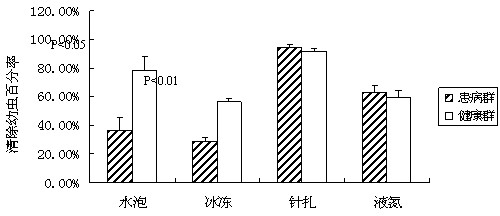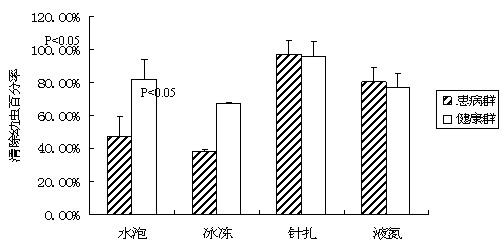Method for testing chalkbrood disease-resisting capability of swarms
A technology of chalk resistance and bee colony, which is applied in the field of bee breeding, can solve problems such as laboriousness, inability to judge the ability of bee colonies to resist chalk disease, troubles, etc., and achieve the effects of improving breeding efficiency, low cost, and improving breeding efficiency
- Summary
- Abstract
- Description
- Claims
- Application Information
AI Technical Summary
Problems solved by technology
Method used
Image
Examples
Embodiment 1
[0025] Embodiment 1: the detection of the clearance rate of the dead capper between the chalk disease patient colony and the healthy bee colony
[0026] In the experimental bee farm of Huajiachi Campus, Zhejiang University, three colonies of chalky bees (experimental group) and three colonies of healthy bees (control group) with basically the same colony were selected, and each colony was cut with a special honeycomb cutter. Four small capped spleens of 6.5*3.5 cm were taken out, and after being soaked in water for 24 hours, frozen at -20°C for 24 hours, liquid nitrogen, and needled, they were put back into the original group, and the remaining number of capped spleens was observed and recorded every 24 hours. Observed three times in a row. The t-test was used to statistically analyze the significance of the differences between the different treatment methods.
[0027] The percentage of dead caps cleaned by bees in the experimental group and the control group within 24h, 48...
PUM
 Login to View More
Login to View More Abstract
Description
Claims
Application Information
 Login to View More
Login to View More - R&D
- Intellectual Property
- Life Sciences
- Materials
- Tech Scout
- Unparalleled Data Quality
- Higher Quality Content
- 60% Fewer Hallucinations
Browse by: Latest US Patents, China's latest patents, Technical Efficacy Thesaurus, Application Domain, Technology Topic, Popular Technical Reports.
© 2025 PatSnap. All rights reserved.Legal|Privacy policy|Modern Slavery Act Transparency Statement|Sitemap|About US| Contact US: help@patsnap.com


